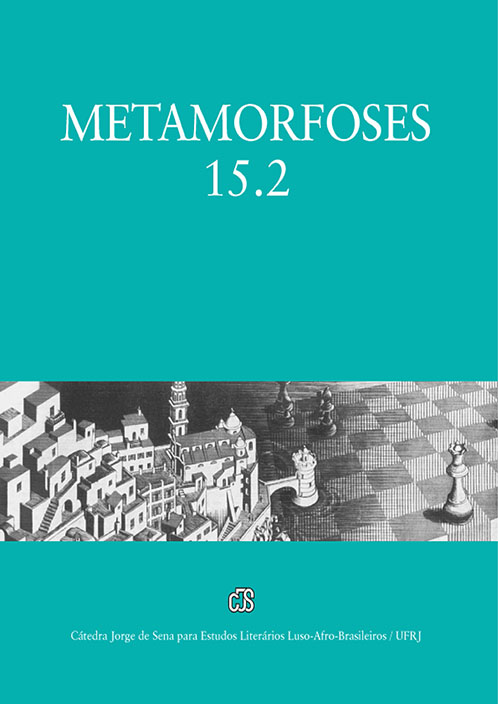The alphabet books and their potentialities in the promotion of a “lecture-literary” competence
DOI:
https://doi.org/10.35520/metamorfoses.2018.v15n2a19221Keywords:
Children’s literature. Picturebook. Alphabet books. “Lecture-literary” competence.Abstract
Integrating the category of picturebooks, the alphabet books or “ABC books” represent one of the oldest categories of children’s book. They present the letters of the alphabet, making them correspond to words and/or images. In some cases, they are composed of uppercase letters and the corresponding lowercase letters, keywords that begin with specific letters, or illustrations of keywords. They may also have phrases or paragraphs of literary nature or are non-literary. Currently, these books show a plurality of graphical and verbo-iconic forms. Well-known authors such as Munari (1907-1998), with ABC (1960), and Sendak (1928-2012), with Alligators All Around (1962), devoted themselves to alphabet books. In Portuguese children’s literature, in addition to titles signed by renowned authors, such as Ducla Soares (1939) or Letria (Cascais, 1951), with ABC (1998) and Alfabeto dos Bichos (2005), respectively, there are some objects with new expressive formulas. Take, for instance, ABZZZZ..., by Isabel Minhós Martins and Yara Kono (2014), and Hoje Sinto-me..., by Madalena Moniz (2014). We intend to reflect on the potential of these books, objects traditionally connoted with didactics, as means of facilitating the learning of letters, but which, in the present, also allow a reading that involves other concepts in the field of ideothematic and literary or artistic construction.
References
Bibliografia activa:
BATAILLE, Marion. ABCD. Barcelona: Editorial Kókinos, 2008.
BLAKE, Quentin. ABC. 2.ed.. London: Red Fox, 2012.
ESTELLON, Pascale. Abécédaire. Paris: Editions des Grandes Personnes, 2016.
DENEUX, Xavier. ABC. Barcelona: Combel, 2016.
JEFFERS, Oliver. Era Uma Vez Um Alfabeto. Lisboa: Orfeu Negro, 2016.
LETRIA, José Jorge. O Alfabeto dos Bichos. [ilustrações de André Letria]. Cruz Quebrada: Oficina do Livro, 2005.
MARTINS, Isabel Minhós. ABZZZZ.... [ilustrações de Yara Kono]. Carcavelos: Planeta Tangerina, 2014.
MONIZ, Madalena. Hoje Sinto-me.... Lisboa: Orfeu Negro, 2014.
MUNARI, Bruno. ABC. San Francisco-Califórnia: Chronicle Books, 2006.
PERRET, Fanny. ABC das Palavras. Lisboa: Edicare, 2014.
ROCHA, Daphne; WOJCIECHOWSKA, Danuta. O que se vê no ABC. Lisboa: Caminho, 2008.
SENDAK, Maurice. Vida de Crocodilo. Um Alfabeto. Matosinhos: Kalandraka, 2017.
Bibliografia passiva:
CARLSON, Ann (s./d.). Concept books and young children. Disponível em: <http://comminfo.rutgers.edu/professional-development/childlit/books/CARLSON.pdf≥ Acesso em: 12 de Julho de 2016.
CARPENTER, Humphrey; PRICHARD, Mari. The Oxford Companion to Children's Literature. Oxford/NY: Oxford University Press, 2004.
CARTER, David A. e DIAZ, James. Los Elementos del Pop-Up. Barcelona: Combel Editorial, 2009.
CARVALHO, Anabela; TOMÉ, Maria da Conceição. O desafio de formar leitores competentes. In: VIANA, Fernanda Leopoldina; RIBEIRO, Iolanda; BAPTISTA, Adriana (coord.). Ler para ser. Os caminhos antes, durante e... depois de aprender a ler. Coimbra: Edições Almedina, p. 237-275, 2014.
DURAN, Teresa. Del abecedario al álbum ilustrado. Cuadernos de Literatura Infantil y Juvenil -- CLIJ. Barcelona, Fontalba, p. 19-25, Abril de 1998.
DURAN, Teresa. Leer antes de ler. Madrid: Anaya, 2002.
GOMES, José António. Para uma história da literatura portuguesa para a infância e para a juventude. Lisboa: IPLB-MC, 1997.
LERER, Seth. La magia de los libros infantiles. Barcelona: Ares y Mares, 2009.
RAMOS, Ana Margarida. Livros de Palmo e Meio. reflexões sobre literatura para a infância. Lisboa: Caminho, 2007.
SANJUÁN, Marta. Los abecedarios ilustrados como “artefactos” estéticos y literarios: aproximación a su poética. Ocnos. Revista de estudios sobre lectura, nº 14, p. 42-64, 2015.
SALISBURY, Martin. Illustrating children's books. Creating pictures for publication. NY: Barron's, 2004.
SALISBURY, Martin; STYLES, Morag. Children's picturebooks. The art of visual storytelling. London: Laurence King, 2012.
SILVA, Sara Reis da. Ilustração e poesia: para uma definição/caracterização do álbum poético para a infância. GONZÁLEZ, Reyes; MOLEÓN VIANA, M. A. & GONZÁLEZ CASTRO, M. (ed.). Actas del I congreso internacional de arte, ilustración y cultura visual en educación infantil y primaria: construcción de identidades. Granada: Universidad de Granada, p. 565-570, 2010.
TREBBI, Jean-Charles. The art of pop-up: the magical world of three-dimensional books. Barcelona: PromoPress, 2012.
VAN DER LINDEN, Sophie. Lire l' Album. Le Puy-en-Velay: L'atelier du poisson soluble, 2008.
VIANA, Fernanda Leopoldina; RIBEIRO, Iolanda; BAPTISTA, Adriana (coord.). Ler para ser. Os caminhos antes, durante e... depois de aprender a ler. Coimbra: Edições Almedina, 2014.
WHITEHURST, Grover; LONIGAN, Christopher. Child development and emergent literacy. Child Development, 69(3), p. 848-872, 1988.
WHITEHURST, G.; LONIGAN, C.. Emergent literacy: development from pre-readers. In: NEUMAN, Susan B.; DICKINSON, David K. (ed.). Handbook of early literacy research. London: Guilford Press, 2001, p. 11-29.
ZEECE, Pauline Davey. ABC and 123: alphabet and counting books. Early Childhood Education Journal. v. 23, nº 3. p. 159-162, 1996.
Downloads
Published
Issue
Section
License
Autores que publicam nesta revista concordam com os seguintes termos:
- Autores mantêm os direitos autorais e concedem à revista o direito de primeira publicação, com o trabalho simultaneamente licenciado sob a Licença Creative Commons Attribution que permite o compartilhamento do trabalho com reconhecimento da autoria e publicação inicial nesta revista.
- Autores têm autorização para assumir contratos adicionais separadamente, para distribuição não-exclusiva da versão do trabalho publicada nesta revista (ex.: publicar em repositório institucional ou como capítulo de livro), com reconhecimento de autoria e publicação inicial nesta revista.
- Autores têm permissão e são estimulados a publicar e distribuir seu trabalho online (ex.: em repositórios institucionais ou na sua página pessoal) a qualquer ponto antes ou durante o processo editorial, já que isso pode gerar alterações produtivas, bem como aumentar o impacto e a citação do trabalho publicado (Veja O Efeito do Acesso Livre).

